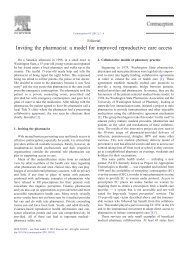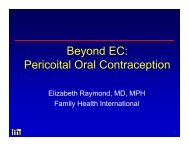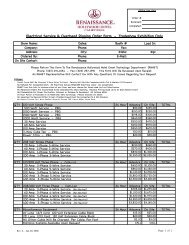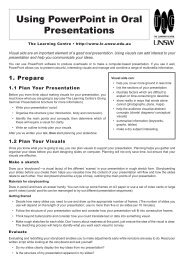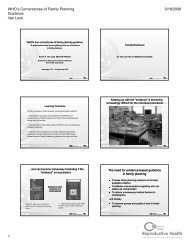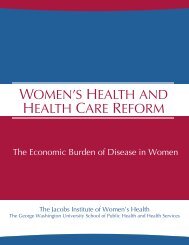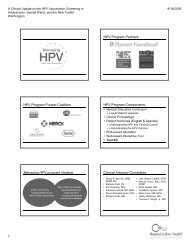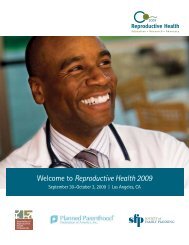Managing Premenstrual Symptoms - Association of Reproductive ...
Managing Premenstrual Symptoms - Association of Reproductive ...
Managing Premenstrual Symptoms - Association of Reproductive ...
Create successful ePaper yourself
Turn your PDF publications into a flip-book with our unique Google optimized e-Paper software.
Definitions<br />
Despite the familiarity <strong>of</strong> premenstrual symptoms to many women,<br />
there is no clear consensus on the definition <strong>of</strong> premenstrual<br />
disorders. Rather, these conditions make up a continuum <strong>of</strong><br />
disorders that are defined according to the nature and severity <strong>of</strong><br />
their symptoms. 1<br />
• <strong>Premenstrual</strong> molimina are the symptoms, sensations,<br />
feelings, and observations, such as bloating, headaches,<br />
nausea, ovulatory pain, and breast tenderness, that many<br />
women experience during the premenstrual phase <strong>of</strong> their<br />
cycles. These symptoms are minor, do not cause functional<br />
impairment, and are minimally distressing. They predict<br />
impending ovulation and subsequent menstruation. If they<br />
occur within 3 days <strong>of</strong> the onset <strong>of</strong> menses and do not<br />
represent a patient’s chief presenting complaint, they are<br />
considered to be a normal part <strong>of</strong> a woman’s menstrual cycle.<br />
• <strong>Premenstrual</strong> syndrome (PMS) is a term coined in 1931 to<br />
describe a constellation <strong>of</strong> physical and emotional symptoms<br />
unique to women during their childbearing years. 2<br />
<strong>Premenstrual</strong> symptoms in general are <strong>of</strong>ten described or<br />
referred to as PMS. 3 Accepted definitions <strong>of</strong> the disorder<br />
require that symptoms must occur only during the luteal phase<br />
to be considered PMS.<br />
• <strong>Premenstrual</strong> dysphoric disorder (PMDD) is defined by<br />
diagnostic criteria outlined in the Diagnostic and Statistical<br />
Manual <strong>of</strong> Mental Disorders (DSM). 4 Both PMS and PMDD<br />
produce symptoms that are associated with the ovarian cycle<br />
<strong>of</strong> a woman <strong>of</strong> reproductive age. These disorders represent<br />
abnormal responses to normal endocrine changes associated<br />
with ovulation. The symptoms <strong>of</strong> these disorders may continue<br />
to occur during a woman’s menstrual cycle until she reaches<br />
2<br />
The National Library <strong>of</strong> Medicine’s Medical Subject Headings<br />
(MeSH) terminology defines PMS as follows: “A combination <strong>of</strong><br />
distressing physical, psychologic, or behavioral changes that<br />
occur during the luteal phase <strong>of</strong> the menstrual cycle. <strong>Symptoms</strong> <strong>of</strong><br />
PMS are diverse (such as pain, water retention, anxiety, cravings,<br />
and depression) and they diminish markedly 2–3 days after the<br />
initiation <strong>of</strong> menses.”<br />
<strong>Managing</strong> <strong>Premenstrual</strong> <strong>Symptoms</strong> June 2008



